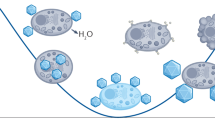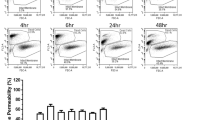Abstract
Background:
Critical to the continual improvement of cryoablation efficacy is deciphering the biochemical responses of cells to low-temperature exposure. The identification of delayed-onset cell death has allowed for the manipulation of cellular responses through the regulation of apoptosis. We hypothesized that in addition to delayed apoptotic events associated with mild subfreezing temperatures (10 to −25 °C), cells exposed to ultra-low temperatures (<−30 °C) may undergo rapid, early-onset apoptosis.
Methods:
Human prostate cancer model and cells (PC-3) were exposed to temperatures of −60, −30 and −15 °C to simulate a cryoablative procedure. Using a combination of flow-cytometry, fluorescent microscopy and western blot analyses, samples were assessed at various times post thaw to identify the presence, levels and the pathways involved in cell death.
Results:
Exposure to temperatures <−30 °C yielded a significant apoptotic population within 30 min of thawing, peaking at 90 min (∼40%), and by 6 h, only necrosis was observed. In samples only reaching temperatures >−30 °C, apoptosis was not noted until 6–24 h post thaw, with the levels of apoptosis reaching ∼10% (−15 °C) and ∼25% (−30 °C) at 6 h post thaw. Further, it was found that early-onset apoptosis progressed through a membrane-mediated mechanism, whereas delayed apoptosis progressed through a mitochondrial path.
Conclusions:
These data demonstrate the impact of apoptotic continuum, whereby the more severe cryogenic stress activated the extrinsic, membrane-regulated pathway, whereas less severe freezing activated the intrinsic, mitochondrial-mediated path. The rapid induction and progression of apoptosis at ultra-low temperatures provides an explanation as to why such results have not previously been identified following freezing. Ultimately, an understanding of the events and signaling pathways involved in triggering apoptosis following freezing may provide a path for selective induction of the rapid-onset and delayed programmed cell death pathways in an effort to improve the overall cryoablation efficacy.
This is a preview of subscription content, access via your institution
Access options
Subscribe to this journal
Receive 4 print issues and online access
$259.00 per year
only $64.75 per issue
Buy this article
- Purchase on Springer Link
- Instant access to full article PDF
Prices may be subject to local taxes which are calculated during checkout






Similar content being viewed by others
References
Cohen JK, Miller RJJ, Ahmed S, Lotz MJ, Baust JG . Ten-year biochemical disease control for patients with prostate cancer treated with cryosurgery as primary therapy. Urology 2008; 71: 515–518.
Babaian RJ, Donnelly B, Bahn D, Baust JG, Dineen M, Ellis D et al. Best practice statement on cryosurgery for the treatment of localized prostate cancer. J Urol 2008; 180: 1993–2004.
Erinjeri JP, Clark TW . Cryoablation: mechanism of action and devices. J Vasc Interv Radiol 2010; 21 (Suppl 8): S187–S191.
Woolley ML, Schulsinger DA, Durand DB, Zeltser IS, Waltzer WC . Effect of freezing parameters (freeze cycle and thaw process) on tissue destruction following renal cryoablation. J Endourol 2002; 16: 519–522.
Gage AA, Baust JG . Mechanisms of tissue injury in cryosurgery. Cryobiology 1998; 37: 171–186.
Hollister WR, Mathew AJ, Baust JG, Van Buskirk RG . Effects of freezing on cell viability and mechanisms of cell death in a human prostate cell line. Mol Urol 1998; 2: 13–18.
Baust JG, Gage AA, Robilotto AT, Baust JM . The pathophysiology of thermoablation: optimizing cryoablation. Curr Opin Urol 2009; 19: 127–132.
Kimura M, Rabbani Z, Mouraviev V, Tsivian M, Vujaskovic Z, Satoh T et al. Morphology of hypoxia following cryoablation in a prostate cancer murine model: its relationship to necrosis, apoptosis and, microvessel density. Cryobiology 2010; 61: 148–154.
Levy D, Avallone A, Jones JS . Current state of urological cryosurgery: prostate and kidney. BJU Int 2010; 105: 590–600.
Basco MT, Yiu WK, Cheng SW, Sumpio BE . The effects of freezing versus supercooling on vascular cells: implications for balloon cryoplasty. J Vasc Interv Radiol 2010; 21: 910–915.
Baust JG, Gage AA . The molecular basis of cryosurgery. BJU Int 2005; 95: 1187–1191.
Cheng Y, Gulbins E, Siemen D . Activation of the permeability transition pore by Bax via inhibition of the mitochondrial BK channel. Cell Physiol Biochem 2011; 27: 191–200.
Narita M, Shimizu S, Ito T, Chittenden T, Lutz RJ, Matsuda H et al. Bax interacts with the permeability transition pore to induce permeability transition and cytochrome c release in isolated mitochondria. Proc Natl Acad Sci USA 1998; 95: 14681–14686.
Kinnally KW, Antonsson B . A tale of two mitochondrial channels, MAC and PTP, in apoptosis. Apoptosis 2007; 12: 857–868.
Hanai A, Yang WL, Ravikumar TS . Induction of apoptosis in human colon carcinoma cells HT29 by sublethal cryo-injury: mediation by cytochrome c release. Int J Cancer 2001; 93: 526–533.
Caroppi P, Sinibaldi F, Fiorucci L, Santucci R . Apoptosis and human diseases: mitochondrion damage and lethal role of released cytochrome C as proapoptotic protein. Curr Med Chem 2009; 16: 4058–4065.
Allan LA, Clarke PR . Apoptosis and autophagy: Regulation of caspase-9 by phosphorylation. Febs J 2009; 276: 6063–6073.
Gregoraszczuk E, Ptak A . Involvement of caspase-9 but not caspase-8 in the anti-apoptotic effects of estradiol and 4-OH-Estradiol in MCF-7 human breast cancer cells. Endocr Regul 2011; 45: 3–8.
Yang WL, Addona T, Nair DG, Qi L, Ravikumar TS . Apoptosis induced by cryo-injury in human colorectal cancer cells is associated with mitochondrial dysfunction. Int J Cancer 2003; 103: 360–369.
Lovric MM, Hawkins CJ . TRAIL treatment provokes mutations in surviving cells. Oncogene 2010; 29: 5048–5060.
de Vries EG, Timmer T, Mulder NH, van Geelen CM, van der Graaf WT, Spierings DC et al. Modulation of death receptor pathways in oncology. Drugs Today (Barc) 2003; 39 (Suppl C): 95–109.
Han J, Jogie-Brahim S, Harada A, Oh Y . Insulin-like growth factor-binding protein-3 suppresses tumor growth via activation of caspase-dependent apoptosis and cross-talk with NF-kappaB signaling. Cancer Lett 2011; 307: 200–210.
Cagnol S, Chambard JC . ERK and cell death: mechanisms of ERK-induced cell death--apoptosis, autophagy and senescence. Febs J 2010; 277: 2–21.
Lahti JM, Teitz T, Stupack DG . Does integrin-mediated cell death confer tissue tropism in metastasis? Cancer Res 2006; 66: 5981–5984.
Robilotto AT, Clarke D, Baust JM, Van Buskirk RG, Gage AA, Baust JG . Development of a tissue engineered human prostate tumor equivalent for use in the evaluation of cryoablative techniques. Technol Cancer Res Treat 2007; 6: 81–89.
Rokhlin OW, Guseva N, Tagiyev A, Knudson CM, Cohen MB . Bcl-2 oncoprotein protects the human prostatic carcinoma cell line PC3 from TRAIL-mediated apoptosis. Oncogene 2001; 20: 2836–2843.
Anai S, Goodison S, Shiverick K, Hirao Y, Brown BD, Rosser CJ . Knock-down of Bcl-2 by antisense oligodeoxynucleotides induces radiosensitization and inhibition of angiogenesis in human PC-3 prostate tumor xenografts. Mol Cancer Ther 2007; 6: 101–111.
Chung LW, Zhau HE, Wu TT . Development of human prostate cancer models for chemoprevention and experimental therapeutics studies. J Cell Biochem Suppl 1997; 28–29: 174–181.
Kim JB . Three-dimensional tissue culture models in cancer biology. Semin Cancer Biol 2005; 15: 365–377.
Han B, Grassl ED, Barocas VH, Coad JE, Bischof JC . A cryoinjury model using engineered tissue equivalents for cryosurgical applications. Ann Biomed Eng 2005; 33: 972–982.
Wang R, Xu J, Juliette L, Castilleja A, Love J, Sung SY et al. Three-dimensional co-culture models to study prostate cancer growth, progression, and metastasis to bone. Semin Cancer Biol 2005; 15: 353–364.
Ma YL, Fujiyama C, Masaki Z, Sugihara H . Reconstruction of prostatic acinus-like structure from ventral and dorsolateral prostatic epithelial cells of the rat in three-dimensional collagen gel matrix culture. J Urol 1997; 157: 1025–1031.
Zhuang S, Kochevar IE . Ultraviolet A radiation induces rapid apoptosis of human leukemia cells by Fas ligand-independent activation of the Fas death pathways. Photochem Photobiol 2003; 78: 61–67.
Kimura K, Gelmann EP . Tumor necrosis factor-alpha and Fas activate complementary Fas-associated death domain-dependent pathways that enhance apoptosis induced by gamma-irradiation. J Biol Chem 2000; 275: 8610–8617.
Saragusty J, Gacitua H, Rozenboim I, Arav A . Do physical forces contribute to cryodamage? Biotechnol Bioeng 2009; 104: 719–728.
Znati CA, Werts ED, Kociban DL, Kalnicki S . Variables influencing response of human prostate carcinoma cells to combined radiation and cryotherapy in vitro. Cryobiology 1998; 37: 450.
Cao W, Shiverick KT, Namiki K, Sakai Y, Porvasnik S, Urbanek C et al. Docetaxel and bortezomib downregulate Bcl-2 and sensitize PC-3-Bcl-2 expressing prostate cancer cells to irradiation. World J Urol 2008; 26: 509–516.
Acknowledgements
We thank Dr D Klossner and Dr D Clarke for their technical assistance. This study was partially supported by NIH grant No. 1R43CA123993-01A1. This research was supported in part by funding from NIH and CPSI Biotech.
Author information
Authors and Affiliations
Corresponding author
Ethics declarations
Competing interests
Dr JM Baust, Dr RG Van Buskirk and Mr Robilotto are employees of CPSI Biotech. Drs JG Baust and AA Gage serve as members of the scientific advisory board of CPSI Biotech.
Rights and permissions
About this article
Cite this article
Robilotto, A., Baust, J., Van Buskirk, R. et al. Temperature-dependent activation of differential apoptotic pathways during cryoablation in a human prostate cancer model. Prostate Cancer Prostatic Dis 16, 41–49 (2013). https://doi.org/10.1038/pcan.2012.48
Received:
Revised:
Accepted:
Published:
Issue Date:
DOI: https://doi.org/10.1038/pcan.2012.48
Keywords
This article is cited by
-
Immunological effect of local ablation combined with immunotherapy on solid malignancies
Chinese Journal of Cancer (2017)
-
Re-purposing cryoablation: a combinatorial ‘therapy’ for the destruction of tissue
Prostate Cancer and Prostatic Diseases (2015)



